January 23, 2014
A Nice Day for a Drive..on the Mun
Good evening, ladies and gentlekerbs. Today on stage we have Doodbus and Philmon Kerman, here to describe their recent mission to the Mun to test the KC-0 rover.
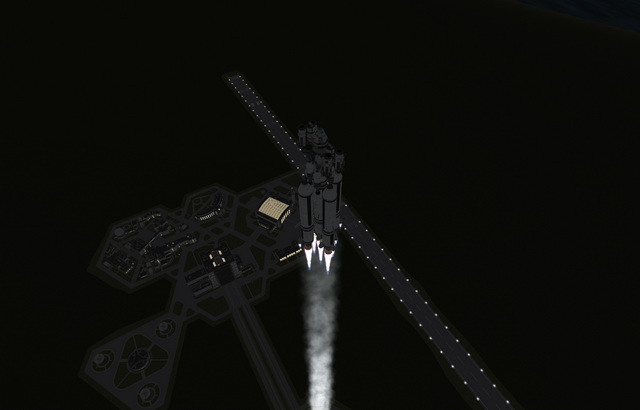
[Philmon] Launch was uneventful. As expected, with the heavier payload, larger fuel capacity, and only slightly increased thrust, initial acceleration was a bit low, and there was some significant wobble shortly after takeoff. I manually disabled thrust vectoring on the outboard main engines, and that decreased the wobble significantly. The outboard boosters detached cleanly, as did the inboard. A normal launch profile would have put me into coast phase shortly after dropping the inboard boosters, but considering my altitude, speed, and fuel state, I decided to continue the burn without a coast phase. I made a long, continued gravity turn, going completely horizontal as we cleared the atmosphere. We had an apoapsis of nearly 100 kilometers and very nearly orbital speed when the launch stage ran out of fuel. With the low thrust of the transfer stage, it took nearly three minutes of thrust to circularize that orbit. I'm not sure a normal flight profile would have kept us above the atmosphere. Clearly this platform needs a bit more delta-v in the launch stack.
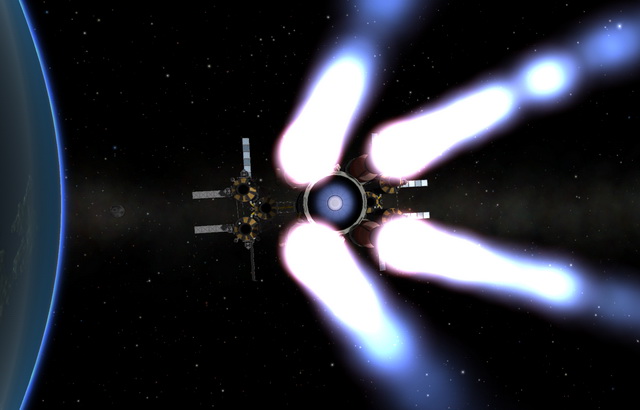
[Philmon] Our transfer window to the Mun opened as we came back over KSC on our first orbit, so I skipped an inspection EVA and fired up the transfer stage again. Another long, four minute burn later, and we had a munar rendezvous plotted. Doodbus and I mostly played cards for the coast out to the Mun. Following Jeb's advice after his rescue mission, I first put the lander into a circular 25 kilomter orbit, and then brought the lander to a complete stop over my chosen landing spot. Doodbus chose the North Polar Crater as his testing environment, so I put the lander into a polar orbit, and began our deceleration burn shortly before we crossed the rim of the crater.
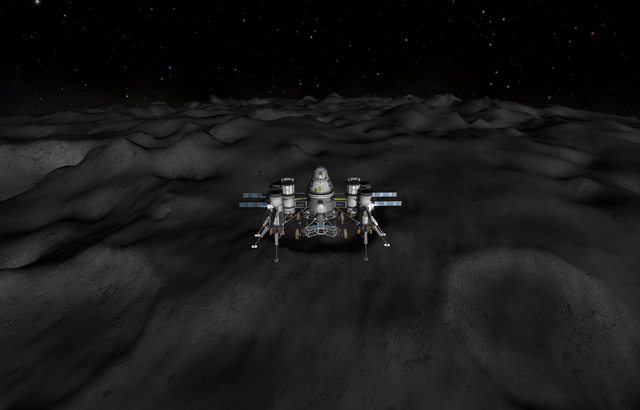
[Philmon] There were a few tense moments during our descent to the Mun as the landing area wasn't as flat as we'd hoped, but the lander was doing fine in terms of fuel use and there was clearly sufficient thrust for an abort if necessary, so we stuck with our course hoping a good flat spot would appear below us, and one did. The landing itself was uneventful, and the lander's fuel tanks were still very nearly full. I began work with the scientific instruments while Doodbus went outside to test the lander.
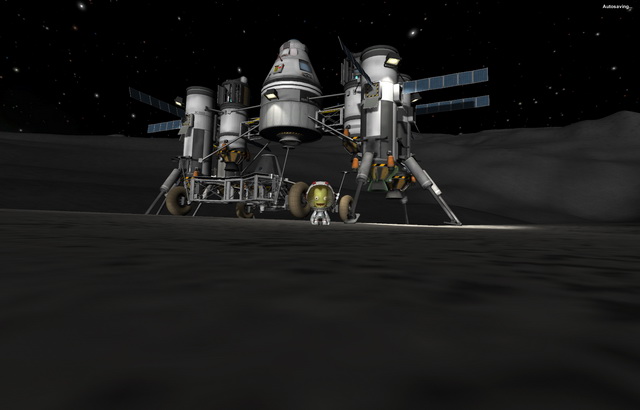
[Doodbus] Philmon had landed us on just the slightest bit of incline, and while the lander legs had settled into the munar surface slightly, the rover was still suspended over the surface about a meter. After I released the locks the lander dropped smoothly to the surface. I had a brief moment of panic as it started to roll, but fortunately the assembly crew had in fact set the brakes and it didn't roll away. Everything on the lander checked out on inspection, so I crawled into the control pod and took a quick spin around the lander as a test. With everything working, I then headed off for a nearby ridge. Driving on the Mun is a bit tricky, but after a kilometer or so I was getting the hang of it. It's a bit thrilling and a bit scary at the same time when just a tiny little bump sends you flying meters above the surface.
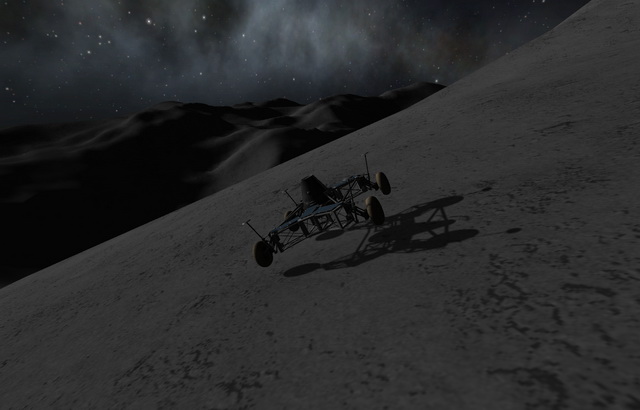
[Doodbus] I was hoping to climb to the top of a nearby mountain to get a wider view of the polar region, but the rover proved incapable of climbing the slope. I'd hit a top speed of 14 meters per second on the flats, but as I hit the mountain side, the rover slowed down, and eventually only the brakes kept me from rolling back down. I did have one scary moment when the rover got sideways and rolled over, plumetting about a kilometer down into the valley with several bounces, flips, and rolls along the way. I must say, I'm glad that I insisted that the first prototype be reinforced and have everything breakable moved in towards the roll center before we finalized the design. I'm also glad that our spacesuits have excellent recycling facilities.
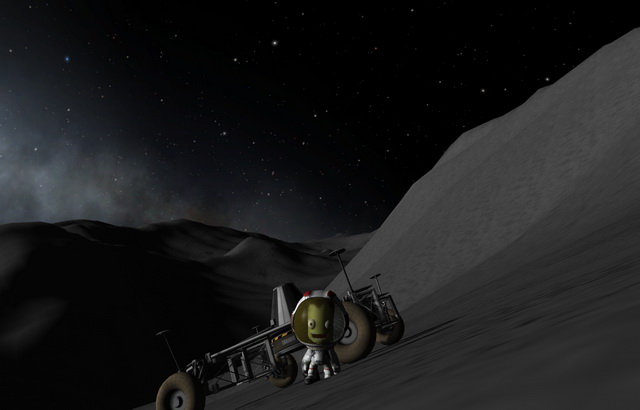
[Doodbus] After I got the rover stabilized, I made an attempt to get out of the valley, but it simply lacked the power to climb back up to the top. I was only three and a half kilometers from the lander, so I parked the rover and used my rocket pack to get back.
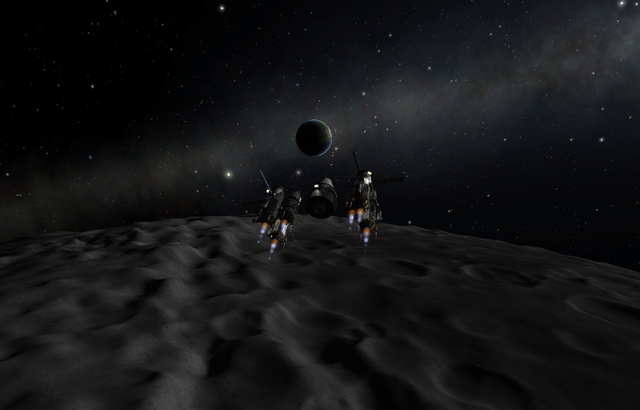
[Philmon] With all that fuel available, I set up a burn during our Kerbin approach to give us a nice slow descent over the tropics on the day side.
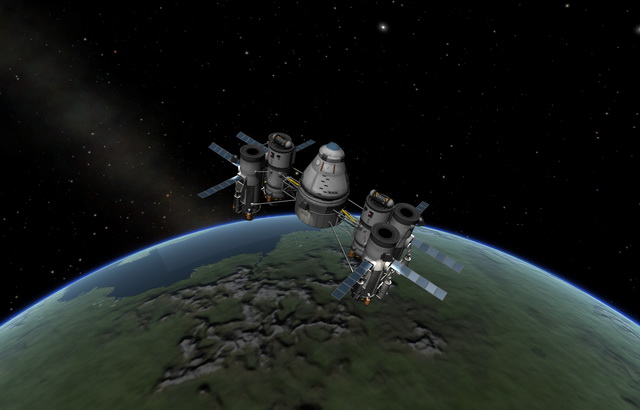
[Philmon] Once the return vehicle was out of fuel, I detached the inboard stages for aerobraking. Re-entry was gentle, and we had a nice float down under canopy to the tropics. I can see why Jeb likes them so much.
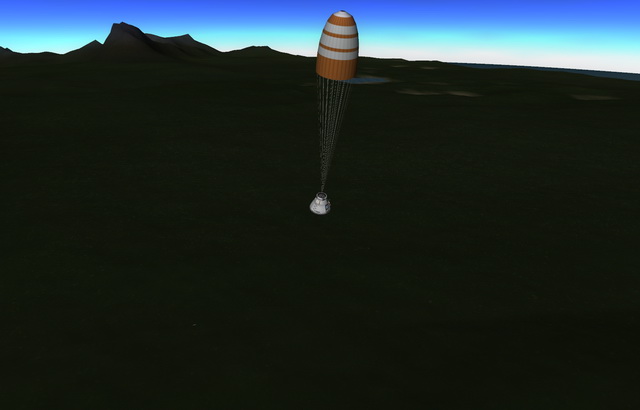
Comments are disabled.
Post is locked.
[Philmon] Thank you, Rod. It's good to be here. For this flight, I was the mission commander and pilot, and Doodbus was the mission specialist for rover operations. The objective for this flight was to go to the Mun, testing the lander-rover attachement system, see if we can successfully deploy a rover to the munar surface, and then test the rover in actual munar conditions. And, of course, to return safely. We would hate to have to interrupt Jeb's tropical vacaction for another rescue mission.
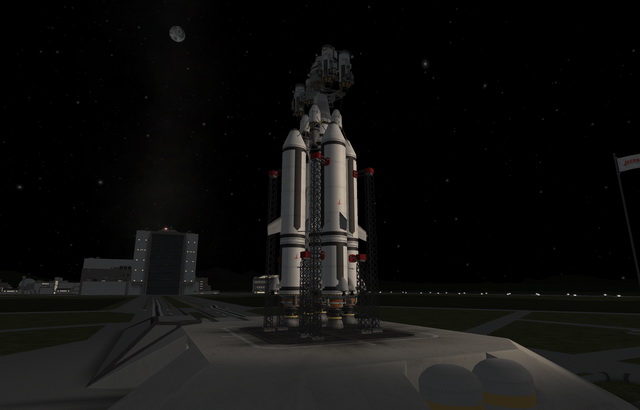
[Doodbus] For this flight, we have another new lander module, configured to cradle a rover between the lander legs. The Kupiter lander consits of a three kerbal pod with a rover slung under it, with propulsion/science pods extended out to the sides to clear the rover. The propulsion pods employ staging, with a small inner stage for Kerbin return, and a pair of larger stages outboard for the munar approach and landing. Only the capsule itself returns to the surface of Kerbin.

[Philmon] The launch vehicle is a slightly modified Kelphin. The main stages are made just a bit larger, with more mark 55 radials added to compensate for the additional mass. The transfer stage has a tapered fuel tank so that it can connect to the docking port on the bottom of the lander/rover assembly.






[Philmon] Once Doodbus was back, we gathered up the various research data from the experiments and set course back for Kerbin. Launching from the poles made it easy, I simply launched straight up, then turned the nose of the spacecraft straight towards Kerbin. Shortly after takeoff from the munar surface, we were on a Kerbin return trajectory, and we were still using the outboard stage of the lander. After my last landing on the Mun, having far more fuel than I needed was a nice change.



Posted by: TheSquirrelPatrol at
10:27 PM
| Comments (1)
| Add Comment
Post contains 1137 words, total size 9 kb.
Posted by: Wonderduck at January 25, 2014 05:03 AM (UVcMa)
17kb generated in CPU 0.0056, elapsed 0.0324 seconds.
36 queries taking 0.028 seconds, 56 records returned.
Powered by Minx 1.1.6c-pink.
36 queries taking 0.028 seconds, 56 records returned.
Powered by Minx 1.1.6c-pink.









